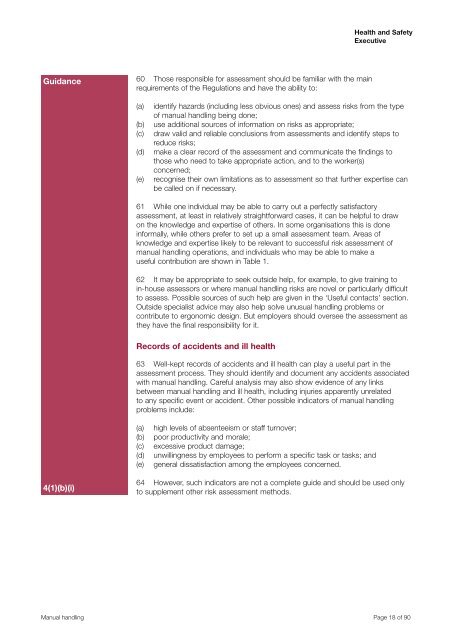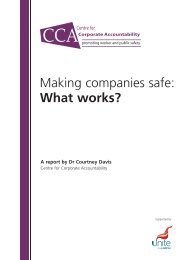Manual Handling Manual Handling Operations Regulations 1992 ...
Manual Handling Manual Handling Operations Regulations 1992 ...
Manual Handling Manual Handling Operations Regulations 1992 ...
You also want an ePaper? Increase the reach of your titles
YUMPU automatically turns print PDFs into web optimized ePapers that Google loves.
Health and Safety<br />
Executive<br />
Guidance<br />
60 Those responsible for assessment should be familiar with the main<br />
requirements of the <strong>Regulations</strong> and have the ability to:<br />
(a)<br />
(b)<br />
(c)<br />
(d)<br />
(e)<br />
identify hazards (including less obvious ones) and assess risks from the type<br />
of manual handling being done;<br />
use additional sources of information on risks as appropriate;<br />
draw valid and reliable conclusions from assessments and identify steps to<br />
reduce risks;<br />
make a clear record of the assessment and communicate the findings to<br />
those who need to take appropriate action, and to the worker(s)<br />
concerned;<br />
recognise their own limitations as to assessment so that further expertise can<br />
be called on if necessary.<br />
61 While one individual may be able to carry out a perfectly satisfactory<br />
assessment, at least in relatively straightforward cases, it can be helpful to draw<br />
on the knowledge and expertise of others. In some organisations this is done<br />
informally, while others prefer to set up a small assessment team. Areas of<br />
knowledge and expertise likely to be relevant to successful risk assessment of<br />
manual handling operations, and individuals who may be able to make a<br />
useful contribution are shown in Table 1.<br />
62 It may be appropriate to seek outside help, for example, to give training to<br />
in-house assessors or where manual handling risks are novel or particularly difficult<br />
to assess. Possible sources of such help are given in the ‘Useful contacts’ section.<br />
Outside specialist advice may also help solve unusual handling problems or<br />
contribute to ergonomic design. But employers should oversee the assessment as<br />
they have the final responsibility for it.<br />
Records of accidents and ill health<br />
63 Well-kept records of accidents and ill health can play a useful part in the<br />
assessment process. They should identify and document any accidents associated<br />
with manual handling. Careful analysis may also show evidence of any links<br />
between manual handling and ill health, including injuries apparently unrelated<br />
to any specific event or accident. Other possible indicators of manual handling<br />
problems include:<br />
(a)<br />
(b)<br />
(c)<br />
(d)<br />
(e)<br />
high levels of absenteeism or staff turnover;<br />
poor productivity and morale;<br />
excessive product damage;<br />
unwillingness by employees to perform a specific task or tasks; and<br />
general dissatisfaction among the employees concerned.<br />
4(1)(b)(i)<br />
64 However, such indicators are not a complete guide and should be used only<br />
to supplement other risk assessment methods.<br />
<strong>Manual</strong> handling Page 18 of 90
















